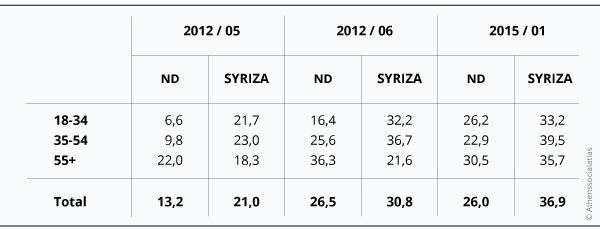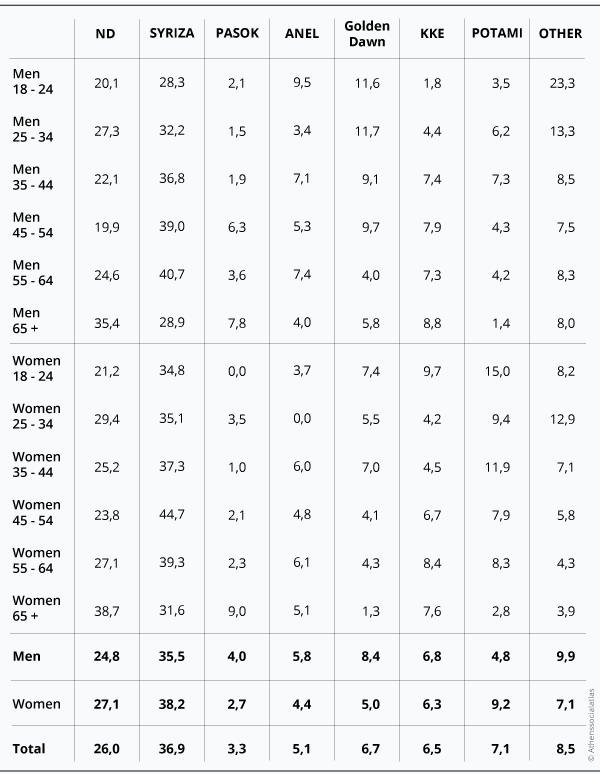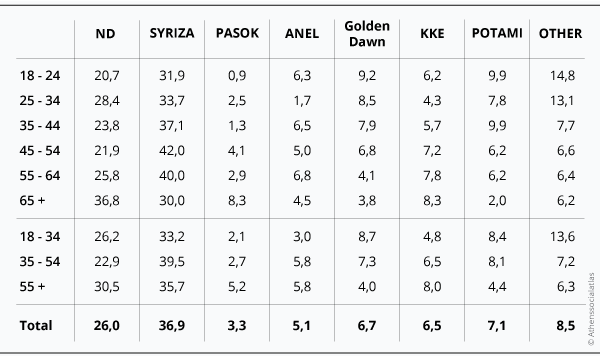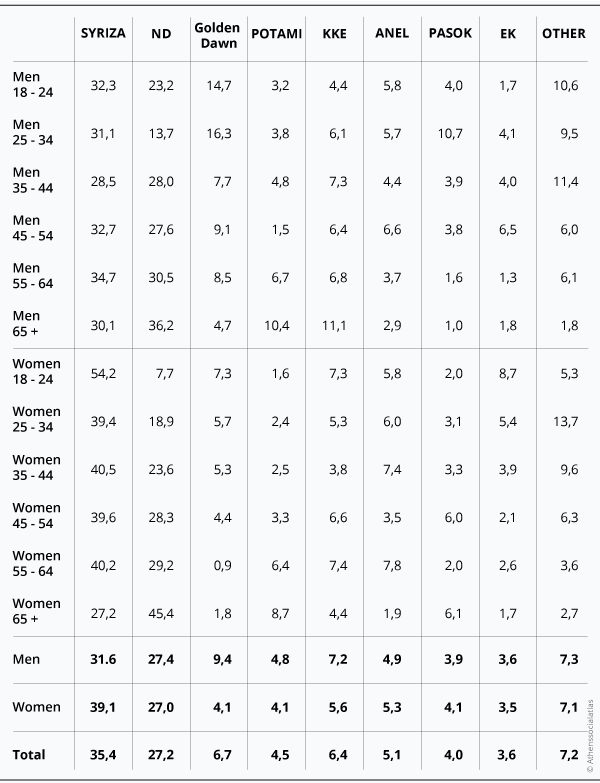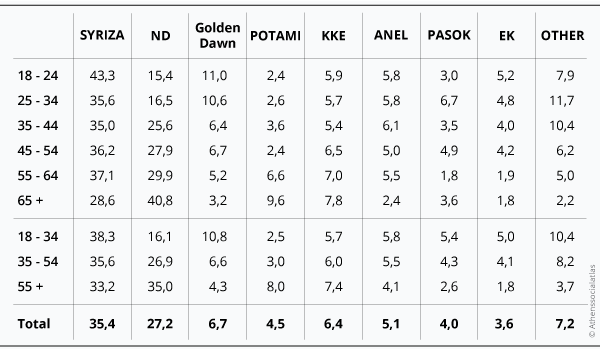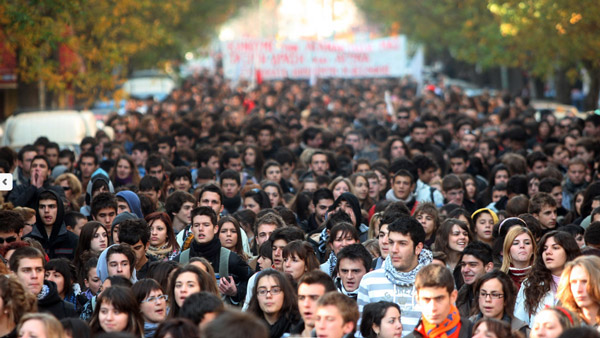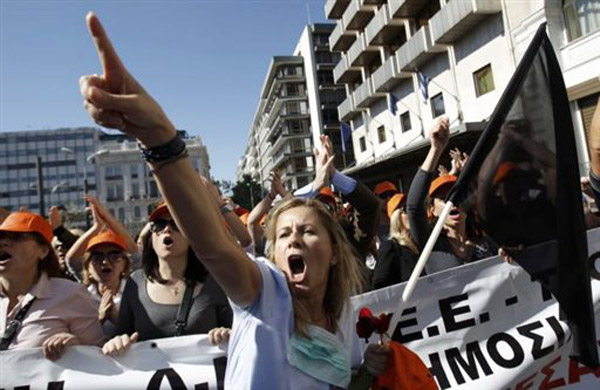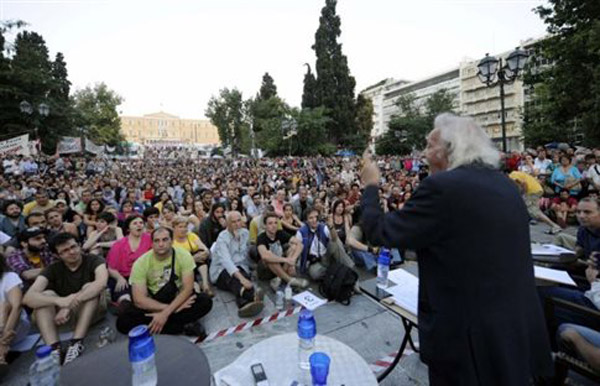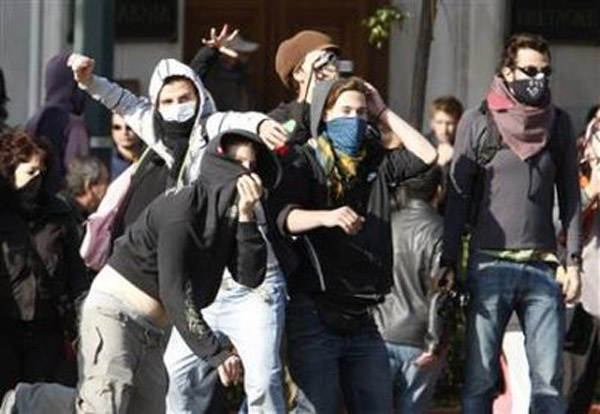Youth and politics: Political attitudes of the young in Athens during the crisis
Pantelidou Maloutas Maro
Politics
2015 | Dec
During the last decades, research data systematically showed a distancing of the young from politics, in the sense of reduced political interest and participation compared to the young in the past, as well as to the middle-aged of the same period. This trend seems to be halted and even reversed by the crisis. While all empirical investigations of the 1990s, show the image of the Greek youth, in harmony with that of other Europeans of the same generation, as primarily individualistic, with reduced socio-political concerns and participation in politics, the crisis, functioning as a strong (re)socialisation factor, operated as a catalyst in this field. In the meantime in 2008, the “December events” –massive, spontaneous, even violent protest of young people after the killing of a 15 year old by a policeman– provoked surprise and heralded the return of the young in politics, manifested later through the protest events of 2011 and the political presence of the young in the elections during the crisis.
The crisis as a strong factor for re-socialisation
The study of the young allows a society to formulate assumptions on its future, while the crisis and especially its management, which created poverty and destitution, constitute strong (re)socialisation factors. Thus, the crisis will have consequences reaching far beyond financial matters, and will also have more lasting and wider ones, assuming that the worst phase of the recession will subside shortly. Cultural phenomena, attitudes and perceptions have a much longer duration, while strong socialisation experiences, such as those generated by the current crisis, have more long-term consequences than the economic recession itself, as they contribute to the formation of political predispositions (Παντελίδου Μαλούτα 1987, 2012). During the crisis the existing socio-political organisation and the hegemony of the neo-liberal ideology expressed in an individualistic life view were de facto discredited. Evidence from recent data permit the assumption that the non-participatory young, considered as a generation acting only “in self interest”, are incentivised towards a reflective process, in which a possible outcome could be the desire for radical changes in existing social conditions perceived as morally unacceptable. A “we” may even be constructed through the participation in spontaneous political events, manifested as outbursts of anger that could evolve into a collective vision for social change.
It became obvious, mainly in the massive protest events of 2011, that young people were returning to politics and sometimes even claimed different than the usual political solutions, based on another understanding of collective coexistence. However, this “we”, built on spontaneous protests in crisis conditions, remains an object of investigation, and while its individualistic starting point is often clear, what is also clear is the strong wish of the young to have a say in their future: “we want to take our fortunes in our own hands”. A sense of collective identity is thus formed, a “we” constructed in practice and eventually evolving in a direction inherent to democracy: Namely that of public interest, solidarity and emphasis on collective problem-solving. The Greek experience of the crisis in 2010-11 actually showed that, when there is also a crisis in representation, then, next to the significant percentage of abstinence-oriented citizens [1], there is another significant proportion that is expressed through direct action in a non-mediated way. This part of the young participates in politics mobilised often with the help of new technology, bypassing devalued political institutions, through horizontal forms of organisation, in squares, neighbourhoods, etc. This does not mean that those who abstain from voting and those involved as “indignants”, denouncing aspects of politics and politicians, form strictly different groups. The opposite is much more true. As for the events of December 2008, they suggested something similar concerning the relation of an apparent “indifference to politics” with political outbursts, but with more complex sociological implications and a more pronounced importance of age as a variable [2].
The survey data of the National Centre for Social Research (EKKE) on the crisis during the first half of 2012 make clear that it is the young who participated more massively in the popular assemblies in squares and the gatherings of the “indignants” in Athens: In the survey sample, 41.9% of young people aged 18-24, compared to an average of 35%, declare that they were involved in popular gatherings at Syntagma Square or in neighbourhoods, and 50%, compared to 41.2%, in gatherings of “indignants”. In 2011, a tendency for diverse and multiform participation was indeed recorded among the young, with almost all forms of action intertwining with each other (Kakepaki 2013), while the elections of 2012 completed the image of the renewed interest of the young in the political process and their diversified involvement. Undoubtedly, the gatherings in squares and popular assemblies contributed to the electoral rise of SYRIZA; it seems that the (until then mainly unmediated) political intervention of young people did not end with the closing of the 2010-2012 conflict circle. Instead, institutional political intervention was added to the unmediated participation.
In regard to gender, we should note that, despite the fact that young women today often feel that gender inequality is less of their concern than middle-aged women (Παντελίδου Μαλούτα 2010) and a gender perspective seems to be generally absent from claims and protests in response to the crisis, young women are increasingly visible in protest, since they are present in such events, even in societies with very traditional gender relations systems, such as Greece. And that, in itself, is probably a very strong indication of gender assertion. Indeed, although generally less present in established forms of political participation, the EKKE survey on the crisis shows the extensive participation of young women in all new channels and alternative forms of mobilisation, with percentages similar to those of young men (Kakepaki 2013). On top of that, we note that 25% of young women aged 15 to 29 years, compared to 18.6% of young men, declare that such involvement is “a way to make my voice heard” as the reason for their participation in protests (Κακεπάκη 2013, 57). Young women seem to take precedence over young men in manifesting need for expression and communication, while they also score higher in another explanation on the reasons for participation: the desire of meeting with others “who share the same concerns”. These justifications reflect a specific criticism of the existing political system and its functioning, as well as a (maybe embryonic) request for participatory democracy.
We should also point out, regarding the Greek political culture, that often young women express themselves as more left-wing than young men, a trend noted in the late 80’s, (Παντελίδου Μαλούτα 1992), and again repeated, with votes in favour of SYRIZA, as shown in the Athens exit polls: 28.3% of young men (18-24 years old), compared to 34.8% of young women, voted for this party in the January 2015 elections. In the elections of June 2012, 20.5% of men aged 18-24 years voted for SYRIZA, compared to 45.4% of young women [3], and in May 2012, 17.5% compared to 26.3%. But of course, SYRIZA has consistently been a “women friendly” party, as also has New Democracy (ND) in regard to female electorate (but with no gender difference among the young in 2015) and Potami. The latter attracted 3.5% of young men’s vote versus 15% of young women’s. Conversely, in January 2015, the primarily “male” Golden Dawn was voted by 11.6% among men aged 18 to 24 and 7.4% among women of the corresponding age.
Youth participation channels
It is testified that during the crisis, there is a particularly increased demand in Greece for participation channels beyond the standard ones. A trend observed much earlier in other societies, where, the relevant literature observes, along with the reduction of traditional modes of political participation, an increased demand for new participation forms already since the 1970s. This especially applies to young, highly educated citizens, who adhere to a post-materialistic system of values, politically placed at the centre and the left on the Left/Right axis (Barnes, Kaase 1979, Kaase, Newton 1998). In the context of the Greek political culture during the crisis, this increased demand and diversity in ways of participation shows that the young now make a distinction between their disregard for the dominant political system and for politics in general, the latter usually generating political indifference: Actually, as shown by the 2012 and 2015 polling data and the events close to the elections, young men and women massively seem to accept the idea that nothing can be done without party politics and electoral processes combined with personal political involvement. Therefore, despite some cases of odious political expression within Greek society, which seem to concern primarily young men (now at a standstill), it can be said that in general, the young during the crisis and because of the crisis are increasingly politicised, and the indications for their choices are increasingly optimistic for a future with greater and more inclusive political participation and thus better democracy.
It is therefore not surprising that the manifestations of civil society in Greece question the stereotype of the relation “hypertrophic state-atrophic civil society” (Βούλγαρης 2006, 7), while allowing the formulation of the assumption that now young men and women can and do express themselves politically in increasing numbers, both in an unmediated way and through traditional participation venues. The latter is an absolutely new factor in regard to the political participation of the young in Greece, who have been distanced from parties, until the crisis: We see thus that the young returned to politics, first through direct action and only later, after important changes in the established party-system, through traditional channels. However this “return of the young to politics” especially regarding the traditional party politics, seems fragile and conditional, as shown by the low rates of party identification of the young.
Intergenerational differences in political participation
The intergenerational changes in the electoral behaviour, reflecting the socialisation period of the basic political formation of specific age groups, are considered, as already noted, the most important factor of change in all political systems. In fact, the double elections in 2012 [that questioned certainties to such an extent that justified their description as an “electoral earthquake” (Βούλγαρης & Νικολακόπουλος 2014)], put forward the age gap noted in the electoral performance of SYRIZA in favour of the younger, as one of the major intersections. Regarding the important changes observed in the 2012 elections, we should remember that in May, 60% of voters changed their party choice compared to that of 2009, while 19% of votes was in favour of a party that eventually remained outside the Parliament (Κουστένης 2014, 84-85). Also, the rise of SYRIZA to second place accompanied the collapse of the traditional two-party system, while among young voters who voted for the first time, SYRIZA came first with 16%, followed by Golden Dawn with 14% (Σταθόπουλος 2014, 67). Furthermore, it is interesting to observe that the younger their age, the closest to ballot voters decide what to vote (Σταθόπουλος 2014, 76), while younger people (18-24 years old) are characterised by lower political identification compared to older ones. It is significant that while younger people (18-24 years old) form the biggest age group refusing auto-classification on the Left-Right axis, which is in line with data traditionally seen in recent decades, at the same time, based on the exit polls of 2012, for the first time in years, the younger present a slightly more wide-spread left identity than the average (17.1%), but also than older age-groups, up to 44 years old: People aged 18-24 years old consider themselves belonging to the Left by 18.5%, at 25-34 by 17.6% and at 35-44 by 15.5%, while people aged 45-54 years old place themselves to the Left by 21.2% (Σταθόπουλος 2014, 79). Concerning the ideological identity of the young, something is certainly changing during the crisis.
However, we should note that if there is an intergenerational gap in voting, as advocated in the relevant literature for the 2012 elections, this is usually documented by a divide of the sample either at age 54 (i.e. voters from 18-54 and voters over 55), or at 44 (18 to 44 and over 45 years old) [4], indeed, younger voters, based on the above categories, voted in much greater numbers for change in the political landscape, as reflected in votes for SYRIZA, while older people voted for traditional parties and especially for ND. However, this divide, presenting comparative trends between younger and older citizens, does not tell us much about the electoral behaviour of the young themselves. An analytical focus on the 18-34 years old is much more interesting, if we want to understand how young people vote.
Table 1: Vote for ND and SYRIZA (%), May and June 2012 and January 2015 (Attica)
Source: Common exit poll of cooperating companies. Statistical analysis by P. Koustenis
In Table 1 we observe that in the three elections of May 2012, June 2012 and January 2015, the middle age group of 35-54 years olds is always the one with the highest percentage of votes for SYRIZA –respectively, 23% (average of 21%), 36.7% (average of 30.8%) and 39.5% (average of 36.9%). The young (18-34 years old) voted for SYRIZA by 21.7%, 32.2% and 33.2%, respectively. Therefore, SYRIZA’s victory in Athens came from the middle aged and not the youngest age group, which in the January 2015 elections voted for this party less than the average, with notable differences regarding gender. Similarly, in all three elections, ND received its largest percentage from older voters. As for electoral abstention, the relatively low identification of young people with political parties and their denial to position themselves on the Left/Right axis, which is greater among them, predispose the young to comparatively higher abstention, which nevertheless cannot be calculated with certainty.
Looking at the age groups of 18-24 and 25-34 separately, regarding their vote in the elections of January 2015, we observe that, within this general category of “the young”, is it the less young, namely 25-34 (mainly among the men), who voted more for SYRIZA.
Table 2.1: Vote in the elections of January 2015 by age and gender % (Attica)
Table 2.2: Vote in the elections of January 2015 by age % (Attica)
Source: Common exit poll of cooperating companies. Statistical analysis by P. Koustenis.
We see that in almost all age groups, women vote more massively in favour of SYRIZA compared to men, with women aged 18-24 years having a lead of 6.5 points. The other pole of the Left, KKE, is generally voted equally by both men and women, getting the highest percentages from people aged 55+ and presenting an unexpectedly high score (which raises questions) for young women (9.7%, compared to just 1.8% for young men). It is worth adding that in these elections, according to the common exit polls of the cooperating companies, almost half of young men and 60% of young women decided what to vote on the election day or during the last week.
As regards the effect of social class in the electoral choice of young people, conclusions are difficult to draw due to the small sample in the recent exit polls. We can however say that, although in 2007 the young from the highest social strata (based on a broad social division of the city’s residential areas) voted in favour of SYRIZA at a slightly lower rate than the total population of the region, in the elections of June 2012 and January 2015, young people from areas comprising high percentages of upper socioeconomic categories (the northern suburbs, the eastern part of the Municipality of Athens and the Coastal zone from Plaio Faliro to Vouliagmeni), voted for SYRIZA clearly more than other age groups in the same area. This is an indication of the increased radicalisation of young men and women of middle and upper middle class. In the west side of the city, where working-class rates are higher, the age distribution of SYRIZA votes in the elections of June 2012 and January 2015 presents smaller fluctuations.
As for the referendum (July 2015), it seems that the participation of young people in favour of “no” was extremely high, about 80% for the 18-24 year olds and 70% for those aged 25-34, (compared to the national average of 61,3%). These high percentages attest that the young felt concerned by the referendum, the choices offered to them, as well as the proposition of the party that instigated it. Already initiated to direct democracy acts at popular assemblies and meetings, it seemed to the young citizens as if, for the first time, accountable representatives asked for their opinion. Such politics obviously seem to relate to a wide spectrum of young people in Greek political culture, self-expression being an integral part of the attitudes of today’s young in many contemporary societies. But, alongside a democratic, participatory and egalitarian world view of the Left, attitudes referring to a wounded national pride were also expressed among the “no” voters. To make things even more complex, the yes/no divide in the 2015 referendum was strongly related to class: The vote for “yes” reached 85% in the most exclusive suburbs of Athens, while “no” reached close to 80% in several working-class suburbs.
It is interesting to note that although the massive “no” of the young was not managed politically as expected, it did not disappoint, nor discouraged young voters, as shown by the September 2015 elections. Bypassing the issue of abstention (for reasons related to the inability of establishing an accurate measure based on the electoral roll, and although abstention certainly increased in September compared to January), we should note that this time there was not a very significant deviation in favour of the 35-54 years old voting for SYRIZA, as observed in January, compared to those aged 18-34: 38.3% against 35.6% in Attica (based on information from the common exit poll). Actually, if we make a finer segmentation, we see that for the first time, the very young (18-24) voted by more than 43% for SYRIZA, while for the first time, over half of young women (18-24 years old) voted in its favour (54.2%).
Table 3.1: Vote in the elections of September 2015 by age and gender % (Attica)
Table 3.2: Vote in the elections of September 2015 by age % (Attica)
Source: Common exit poll of cooperating companies. Statistical analysis by P. Koustenis
The lead of the younger over all other age groups in votes for SYRIZA, both among men (with ups and downs), and, mainly and by far, among women, is impressive. Overall regarding the younger generations, it is the first time that the 18-24 year old age group massively selects the leading party over all other age groups, recording a new turn to the Left, reminiscent of previous decades, i.e. previous generations [5]. It should be noted that the same correlation curve for age and vote for SYRIZA recorded for Attica, with the highest point in the younger age group, is also observed though data for the whole country. This is also an important finding concerning the return of the young, and constitutes an answer to the question “who are the young that seem to be returning to party politics?” There is no longer any material difference between Athens and the rest of the country, as SYRIZA also gained the lead in rural areas in the September elections, while all evidence supports the hypothesis of the radicalisation of youth. The Left overall accounted for more than 50% of votes by the young and more than 60% by young women in Athens. The percentages in the rest of the country are not much lower. At the same time, SYRIZA confirmed once again its position as a primarily “woman friendly” party, since although it lost part of its electoral power in September amongst men (-3.2) it gained more from women (+1.9). Finally, despite the observations concerning the radicalisation of the youth from middle and upper middle class, it seems that in the September electorate social polarisation was intensified in the Athens area [6].
In conclusion, we could say that while the crisis intensified pre-existing tendencies within the Greek political culture in many respects, it seems that in many others it functioned as an inhibitor of specific tendencies or even had subversive results. Regarding the young, the halting of indifference for politics, which had already been noticed in 2008, seems to increase, resulting in the documented renewed interest and the return of the young in politics during the crisis. And if the pre-existing erosion of citizens’ relations with the parties seems to worsen in the crisis and an absolute rupture appears for many of them, new partisan identifications arise, perhaps of a different nature, and certainly with other value-related connotations. The young, men and women, now intervene in the political process, contradicting the model of a non-politicised youth, dynamically participating both through modern channels and in an unmediated way, and then, also through the traditional pillars of democracy and parliamentarianism, i.e. the political parties; but mainly through a party that challenges the established two-party system of the post-dictatorial period. Young Athenians, men and women of 18-24 years old, are en masse present at the forefront of this trend. The re-socialisation process has dynamically started, and the results are already evident in many ways, primarily in Athens. However, any such data, testifying important changes, should not be taken for granted. On the contrary, they are fragile, conditional and constantly under renegotiation. We can even legitimately ask ourselves whether this is indeed both a qualitative and quantitative change in the participatory predisposition of the young, or an individual, coincidental expression of a different way of being a citizen, testified for years by young men and women. Taking into account that this political generation is addicted to self-expression and opinion declaration on its likes and dislikes, seeking to be involved in whatever concerns it, and focused on individual autonomy, we should note that, if, indeed the young are massively involved again in the functioning of parliamentary democracy, the latter should primarily not disappoint them if this situation is to be maintained. That is, it should constantly try to convince them that their participation counts, and that, therefore, the established political process “is of their concern”.
[1] About 1/3 of the total, based on estimates of poll data, according to G. Mavris, manager of Public Issue, in an interview with Avgi Magazine, 10 July 2011.
[2] See Vradis, Dalakoglou (2011), Kalyvas (2010), and Johnston, Seferiades (2012) for the events of December 2008 in Athens.
[3] This percentage seems excessive. It was checked multiple times for its correctness; however, the small absolute numbers forbid any certainty on exact percentages, but they capture the main trend.
[4] For the first case, see Voulgaris, Nicolakopoulos (Βούλγαρης & Νικολακόπουλος 2014, 27) and for the second, Stathopoulos (Σταθόπουλος 2014, 72). The first segmentation seems more appropriate for May and the second for June 2012.
[5] The data in table 3 provide an enormous wealth of information, as do those in Table 2. Here they only used to support the main argument.
[6] Based on calculations by Elias Nicolakopoulos who refers to the official election results. Ta Nea, 22.9.2015.
Entry citation
Pantelidou Maloutas, M. (2015) Youth and politics: Political attitudes of the young in Athens during the crisis, in Maloutas T., Spyrellis S. (eds) Athens Social Atlas. Digital compendium of texts and visual material. URL: https://www.athenssocialatlas.gr/en/article/youth-and-politics-ii/ , DOI: 10.17902/20971.20
Atlas citation
Maloutas T., Spyrellis S. (eds) (2015) Athens Social Atlas. Digital compendium of texts and visual material. URL: https://www.athenssocialatlas.gr/en/ , DOI: 10.17902/20971.9
References
- Βούλγαρης Γ (2006) Κράτος και κοινωνία πολιτών στην Ελλάδα. Μια σχέση προς επανεξέταση. Ελληνική Επιθεώρηση Πολιτικής Επιστήμης 28: 5–33.
- Βούλγαρης Γ και Νικολακόπουλος Η (επιμ.) (2014) Ο διπλός εκλογικός σεισμός. Αθήνα: Θεμέλιο.
- Κακεπάκη Μ (2013) Είναι ένας νέος τρόπος να ακουστεί η φωνή μου: έμφυλες διαστάσεις της συλλογικής και ατομικής δράσης στην Αθήνα της κρίσης. Ελληνική Επιθεώρηση Πολιτικής Επιστήμης 41: 35–59.
- Κουστένης Π (2014) Αποδόμηση και αναδόμηση των εκλογικών ταυτίσεων. Η κοινωνιολογική ανίχνευση του λεκανοπεδίου. Στο: Βούλγαρης Γ και Νικολακόπουλος Η (επιμ.), Ο διπλός εκλογικός σεισμός, Αθήνα: Θεμέλιο, σσ 83–123.
- Παντελίδου Μαλούτα Μ (1987) Πολιτικές στάσεις και αντιλήψεις στην αρχή της εφηβείας. 1η έκδ. Τσαούσης ΔΓ (επιμ.), Αθήνα: Gutenberg.
- Παντελίδου Μαλούτα Μ (1992) Γυναίκες και πολιτική. Αθήνα: Gutenberg.
- Παντελίδου Μαλούτα Μ (2012) Πολιτική Συμπεριφορά: Θεωρία, Έρευνα και Ελληνική Πολιτική. Αθήνα: Σαββάλας.
- Παντελίδου Μαλούτα Μ (2010) Αλλαγές στις πολιτικές αντιλήψεις των νέων γυναικών στο τέλος του 20ου αιώνα. Στο: Καραμανωλάκης Β, Ολυμπίτου Ε, και Παπαθανασίου Ι (επιμ.), Η ελληνική νεολαία τον 20ο αιώνα, Αθήνα: Αρχεία Σύγχρονης Κοινωνικής Ιστορίας, Ινστιτούτο Ν. Πουλαντζάς, Θεμέλιο, σ 470.
- Σταθόπουλος Π (2014) Απορύθμιση του κομματικού συστήματος. Στο: Βούλγαρης Γ και Νικολακόπουλος Η (επιμ.), Ο διπλός εκλογικός σεισμός, Αθήνα: Θεμέλιο, σσ 61–81.
- Barnes SH and Kaase M (1979) Political action: Mass participation in five western democracies. London: Sage Publications.
- Johnston H and Seferiades S (2012) The Greek December, 2008. In: Seferiades S and Johnston H (eds), Violent Protest, Contentious Politics, and the Neoliberal State, Surrey, Burlington: Ashgate, pp. 149–156.
- Kaase M and Newton K (1998) Beliefs in government. Kaase M and Newton K (eds), New York: Oxford University Press.
- Kalyvas A (2010) An anomaly? Some reflections on the Greek December 2008. Constellations, Wiley Online Library 17(2): 351–365.
- Vradis A and Dalakoglou D (eds) (2011) Revolt and crisis in Greece. AKPress, Occupied London, Oakland, Baltimore, Edinburgh, London, Athens: AK Press & Occupied London.

